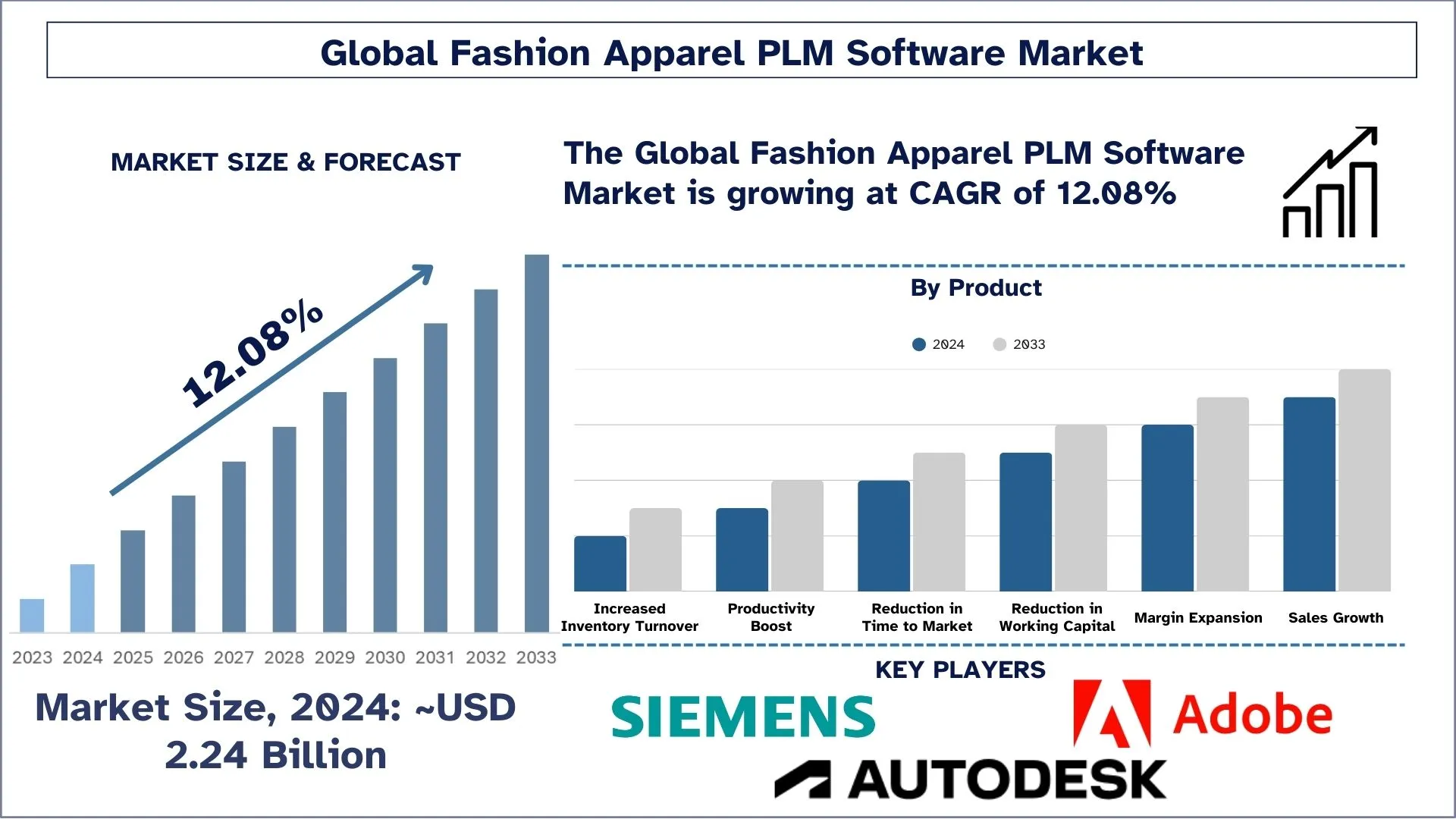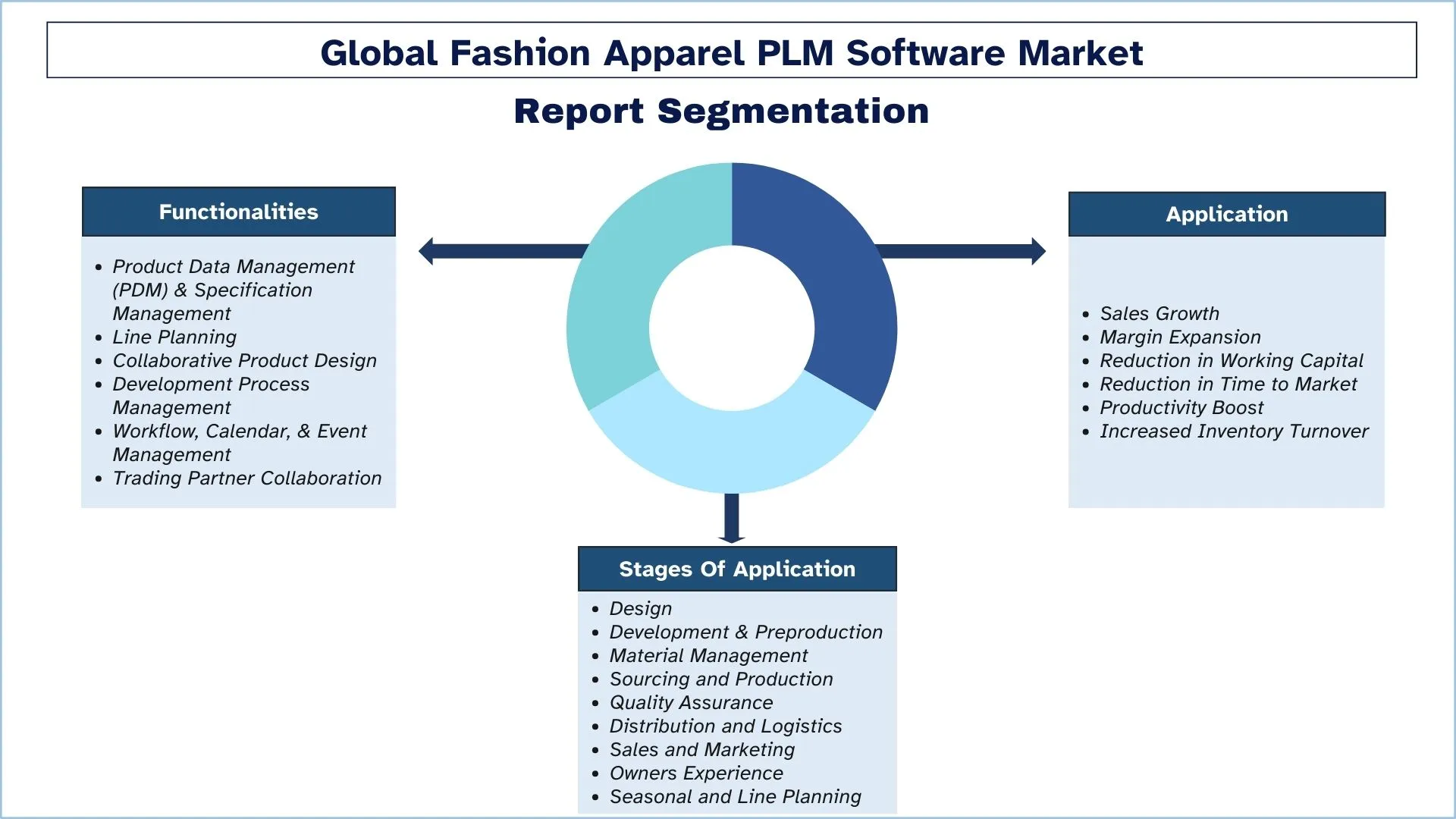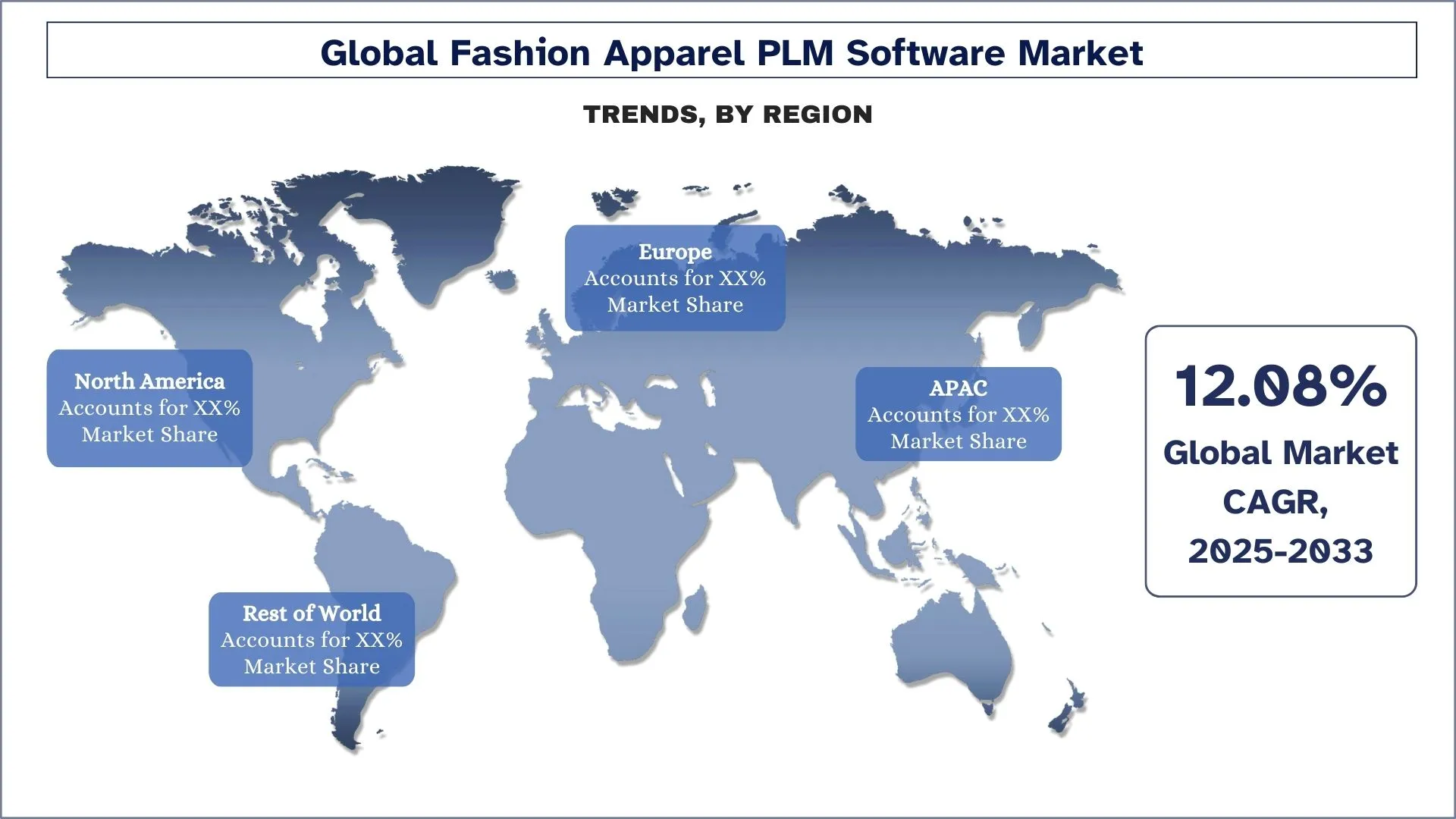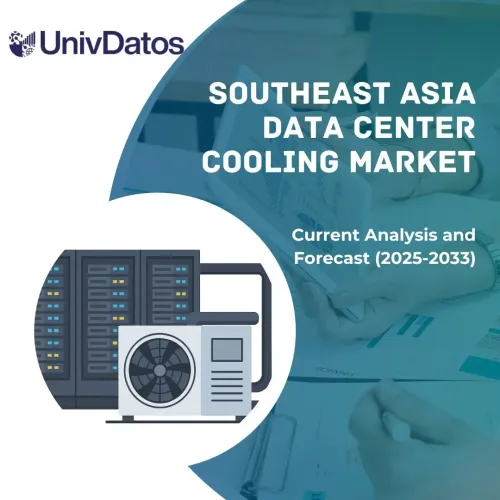- Home
- About Us
- Industry
- Services
- Reading
- Contact Us
Fashion Apparel PLM Software Market: Current Analysis and Forecast (2025-2033)
Emphasis on Functionalities (Product Data Management and Specification Management, Line Planning, Collaborative Product Design, Development Process Management, Workflow, Calendar, and Event Management, and Trading Partner Collaboration); Application (Sales Growth, Margin Expansion, Reduction In Working Capital, Reduction In Time To Market, Productivity Boost, and Increased Inventory Turnover); Stages of Application (Design, Development and Preproduction, Material Management, Sourcing and Production, Quality Assurance, Distribution and Logistics, Sales and Marketing, Owners Experience, and Seasonal and Line Planning); and Region/Country

Fashion Apparel PLM Software Market Size & Forecast
The Fashion Apparel PLM Software market was valued at approximately USD 2.24 billion in 2024 and is expected to grow at a substantial CAGR of around 12.08% during the forecast period (2025-2033), owing to the need for faster product development cycles.
Fashion Apparel PLM Software Market Analysis
One of the primary drivers behind the increasing demand for fashion and apparel products is the rise of e-commerce. With the convenience of online shopping, consumers now have access to a vast array of fashion options from around the world at their fingertips. Furthermore, social media platforms have also played a crucial role in fueling the demand for fashion and apparel products. Influencers and celebrities regularly highlight trendy outfits and styles to their followers, driving consumer interest and influencing purchasing decisions. For instance, according to a study by Bazaarvoice, 70% of consumers are more likely to make a purchase based on social media recommendations, highlighting the significant impact of social media on fashion consumption. Moreover, the growing demand for fashion and apparel products has also spurred an increased interest in fashion apparel Product Lifecycle Management (PLM) software in the markets. PLM software helps fashion companies streamline their product development processes, manage supply chains efficiently, and reduce time-to-market for new products. As companies strive to meet the demands of an ever-evolving fashion industry, the adoption of PLM software has become crucial for staying competitive.
Fashion Apparel PLM Software Market Trends
This section discusses the key market trends influencing the various segments of the Fashion Apparel PLM Software market as identified by our research experts.
Integration of 3D Design and Virtual Sampling
The fashion apparel PLM software market continues to expand because of 3D design and virtual sampling instruments integration. Digital prototyping through this trend lets brands develop and inspect prototypes digitally which causes their products to reach the market faster with reduced sample production and reduced costs. Sustainability efforts find support through PLM because it helps reduce both material waste and environmental impact. Fashion organizations that adopt digital-first operations now depend on 3D capabilities in contemporary PLM platforms as a fundamental requirement.

Fashion Apparel PLM Software Market Industry Segmentation
This section provides an analysis of the key trends in each segment of the global Fashion Apparel PLM Software market report, along with forecasts at the global, regional, and country levels for 2025-2033.
The Product Data Management and Specification Management Segment is Expected to Witness a Higher CAGR than the Fashion Apparel PLM Software Market.
Based on functionalities, the market is categorized into product data management and specification management, line planning, collaborative product design, development process management, workflow, calendar, event management, and trading partner collaboration. One of the core functionalities that generates maximum demand for PLM software is Product Data Management and Specification Management. This feature enables fashion brands to centralize and manage all product-related information, including design specifications, materials, and pricing. By providing a single source of truth for product data, companies can reduce errors, improve accuracy, and enhance decision-making processes throughout the product lifecycle. Furthermore, Line Planning is another critical aspect that holds a significant market share within the fashion apparel PLM software segment. Several factors contribute to the market domination of these core functionalities within the fashion apparel PLM software segment. For instance, the increasing complexity and globalization of supply chains in the fashion industry necessitate robust solutions that can manage vast amounts of data, streamline processes, and foster collaboration across geographies, and are playing a pivotal role in fueling the growth in demand for the fashion apparel PLM software in the global markets.
The Reduction in Time to Market Segment Holds the Largest Share of the Market.
Based on application, the market is segmented into sales growth, margin expansion, reduction in working capital, reduction in time to market, productivity boost, and increased inventory turnover. The reduction in time to market applications stands out as a critical factor for businesses in the fashion apparel industry. This is because the fashion industry is highly competitive, with trends changing rapidly and consumer preferences evolving constantly. As a result, companies need to innovate quickly and efficiently to stay ahead of the curve. Furthermore, the fashion industry operates on a seasonal basis, with companies releasing new collections multiple times a year. Quick turnaround times are crucial to ensure that products are available to consumers at the right time. Moreover, faster time to market can lead to cost savings for companies by reducing production lead times, minimizing inventory holding costs, and avoiding markdowns on out-of-season merchandise. By leveraging PLM software, businesses in the fashion apparel industry can streamline their design, development, and production processes, enabling them to bring new products to market more quickly and efficiently. PLM software provides a centralized platform for managing product data, collaboration, and workflow automation, helping companies reduce errors, improve communication, and accelerate time to market.
APAC has a significant share of the market in 2024.
Asia Pacific is expected to experience substantial growth in the predicted time. One of the key factors driving Asia Pacific’s dominance in clothing and apparel manufacturing is its cost-effective labor force. Countries like China, Bangladesh, Vietnam, and India offer competitive labor costs, making production more affordable for companies. Furthermore, the region’s rapid urbanization has created a burgeoning middle-class population with higher disposable incomes. This demographic shift has fueled the demand for trendy clothing and apparel items, driving the growth of industry. Moreover, with a vast network of manufacturing facilities and skilled labor, Asia Pacific has become the largest exporter of clothing and apparel products worldwide. China, Bangladesh, and Vietnam are among the top exporters in the region. As Asia Pacific solidifies its position as the biggest manufacturer, exporter, and consumer of clothing and apparel products, the demand for Fashion Apparel Product Lifecycle Management (PLM) software has witnessed a significant surge. PLM software streamlines the design, production, and distribution processes in the fashion industry, helping companies enhance efficiency and stay competitive in the market.
China Dominates the APAC Fashion Apparel PLM Software Market
The Chinese fashion apparel PLM software market is growing fast because China maintains a strong manufacturing sector, and domestic fashion labels are using design efficiency and global competitiveness strategies to improve their businesses. Use of PLM systems among Chinese companies continues to grow due to their needs for both shorter supply chain periods and higher product standards. The government, initiative for digital transformation, together with smart manufacturing, continually drives PLM integration through the entire apparel supply chain.

Fashion Apparel PLM Software Market Industry Competitive Landscape
The Fashion Apparel PLM Software market is competitive, with several global and international players. The key players are adopting different growth strategies to enhance their market presence, such as partnerships, agreements, collaborations, new product launches, geographical expansions, and mergers and acquisitions.
Top Fashion Apparel PLM Software Market Companies
Some of the major players operating in the market are Adobe; Autometrix Precision Cutting Systems, Inc.; Siemens; Corel Corporation; Autodesk Inc.; CGS; TUKATECH; VetiGraph; C-DESIGN Fashion; and K3.
Recent Developments in the Fashion Apparel PLM Software Market
In February 2022, Backbone PLM announced a new Adobe Illustrator plugin that streamlines product development for brands in various industries by providing a centralized system to store design and production data. Designers can now easily create technical sketches, colors, and detailed component renderings with this innovative tool.
Fashion Apparel PLM Software Market Report Coverage
Report Attribute | Details |
Base year | 2024 |
Forecast period | 2025-2033 |
Growth momentum | Accelerate at a CAGR of 12.08% |
Market size 2024 | USD 2.24 Billion |
Regional analysis | APAC, Europe, Asia-Pacific, Rest of the World |
Major contributing region | Asia Pacific is expected to grow at the highest CAGR during the forecasted period. |
Key countries covered | U.S., Canada, Germany, France, UK, Spain, Italy, China, Japan, and India |
Companies profiled | Adobe; Autometrix Precision Cutting Systems, Inc.; Siemens; Corel Corporation; Autodesk Inc.; CGS; TUKATECH; VetiGraph; C-DESIGN Fashion; and K3 |
Report Scope | Market Trends, Drivers, and Restraints; Revenue Estimation and Forecast; Segmentation Analysis; Demand and Supply Side Analysis; Competitive Landscape; Company Profiling |
Segments Covered | By Functionalities, By Application, By Stages of Application, By Region/Country |
Reasons to Buy the Fashion Apparel PLM Software Market Report:
The study includes market sizing and forecasting analysis validated by authenticated key industry experts.
The report presents a quick review of overall industry performance at a glance.
The report covers an in-depth analysis of prominent industry peers with a primary focus on key business financials, product portfolios, expansion strategies, and recent developments.
Detailed examination of drivers, restraints, key trends, and opportunities prevailing in the industry.
The study comprehensively covers the market across different segments.
Deep dive regional-level analysis of the industry.
Customization Options:
The global Fashion Apparel PLM Software market can be customized further as per the requirements or any other market segment. Besides this, UnivDatos understands that you may have your own business needs; hence, feel free to contact us to get a report that completely suits your requirements.
Table of Content
Research Methodology for Fashion Apparel PLM Software Market Analysis (2023-2033)
We analyzed the historical market, estimated the current market, and forecasted the future market of the global Fashion Apparel PLM Software Market to assess its application in major regions worldwide. We conducted exhaustive secondary research to gather historical market data and estimate the current market size. To validate these insights, we carefully reviewed numerous findings and assumptions. Additionally, we conducted in-depth primary interviews with industry experts across the Fashion Apparel PLM Software Market value chain. After validating market figures through these interviews, we used top-down and bottom-up approaches to forecast the overall market size. We then employed market breakdown and data triangulation methods to estimate and analyze the market size of industry segments and sub-segments.
Market Engineering
We employed data triangulation techniques to finalize the overall market estimation and derive precise statistical numbers for each segment and sub-segment of the global Fashion Apparel PLM Software Market. We split the data into several segments and sub-segments by analyzing various parameters and trends, including functionalities, applications, stages of application, and regions within the global Fashion Apparel PLM Software Market.
The main objective of the Global Fashion Apparel PLM Software Market Study
The study identifies current and future trends in the global Fashion Apparel PLM Software Market, providing strategic insights for investors. It highlights regional market attractiveness, enabling industry participants to tap into untapped markets and gain a first-mover advantage. Other quantitative goals of the studies include:
Market Size Analysis: Assess the current and forecast market size of the global Fashion Apparel PLM Software Market and its segments in terms of value (USD).
Fashion Apparel PLM Software Market Segmentation: The study segments the market by functionalities, application, stages of application, and region.
Regulatory Framework & Value Chain Analysis: Examine the regulatory framework, value chain, customer behavior, and competitive landscape of the Fashion Apparel PLM Software Market industry.
Regional Analysis: Conduct a detailed regional analysis for key areas such as Asia Pacific, Europe, North America, and the Rest of the World.
Company Profiles & Growth Strategies: Company profiles of the Fashion Apparel PLM Software Market and the growth strategies adopted by the market leaders to sustain the fast-growing market.
Frequently Asked Questions FAQs
Q1: What is the Fashion Apparel PLM Software market's current size and growth potential?
As of 2024, the global Fashion Apparel PLM Software market is valued at approximately USD 2.24 billion and is projected to grow at a CAGR of 12.08% through 2033.
Q2: What are the driving factors for the growth of the Fashion Apparel PLM Software market?
Fashion brands are under pressure to deliver new collections quickly, and PLM software enables streamlined design, collaboration, and sourcing to reduce time-to-market.
Q3: Which market has the largest share of the Fashion Apparel PLM Software market by product?
The product data management (PDM) & specification management segment dominates the global Fashion Apparel PLM Software market by product segment.
Q4: What are the major trends in the Fashion Apparel PLM Software market?
Many PLM platforms now integrate 3D design tools, allowing virtual prototyping and digital fitting, which helps reduce physical samples and supports sustainability goals.
Q5: Which region will dominate the Fashion Apparel PLM Software market?
The APAC region currently dominates the global Fashion Apparel PLM Software market.
Q6: What are the biggest challenges in the Fashion Apparel PLM Software market?
Ensuring seamless integration of PLM with other systems (like ERP, CAD, or SCM) across dispersed teams and suppliers remains a major implementation and scaling challenge.
Q7: Who are the Top players in the global Fashion Apparel PLM Software market?
The leading companies driving innovation in the Fashion Apparel PLM Software market include:
• Adobe
• Autometrix Precision Cutting Systems, Inc.
• Siemens
• Corel Corporation
• Autodesk Inc.
• CGS
• TUKATECH
• VetiGraph
• C-DESIGN Fashion
• K3
Q8: What key features should businesses look for when selecting a fashion-specific PLM software?
Businesses should prioritize PLM platforms that offer integrated design tools, real-time collaboration, supply chain visibility, and 3D/virtual prototyping capabilities. Compatibility with existing ERP or CAD systems and cloud deployment options are also essential for scalability and flexibility.
Q9: How is AI influencing the evolution of PLM software in the fashion industry?
AI enhances PLM by enabling predictive analytics, automated workflows, and smarter demand forecasting. These innovations help brands make faster, data-driven decisions across product design, sourcing, and inventory planning.
Related Reports
Customers who bought this item also bought










